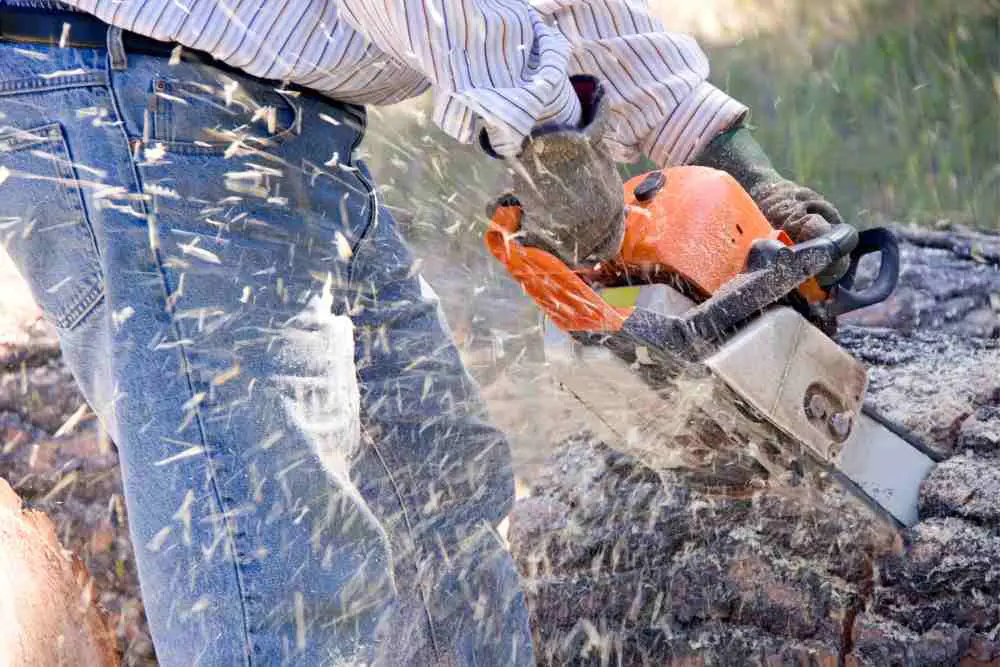A chainsaw should not smoke when cutting as it indicates a problem with the tool. We will explore the possible reasons why chainsaws might produce smoke during operation and provide tips on how to address this issue.
It is essential to ensure that your chainsaw is functioning correctly to maintain its efficiency and prevent any potential hazards. By understanding the causes and solutions to smoking chainsaws, you can take the necessary steps to keep your equipment in proper working order.
So, let’s dive in and explore the common culprits behind chainsaw smoke and how to resolve them effectively.

The Science Behind Chainsaw Smoke
Smoke generation in chainsaws during cutting is a common concern among users. The science behind this issue lies in the combustion process of the chainsaw engine. When the engine is running, fuel and air mix together and ignite, releasing energy for cutting.
However, if the combustion process is not ideal, smoke can be produced. Several factors contribute to smoke generation, including incorrect fuel mixture, clogged air filters, and worn-out spark plugs. These issues hinder efficient combustion and result in excess fuel burning or incomplete combustion, leading to smoke formation.
To prevent smoke during cutting, ensure proper fuel mixture, regularly clean air filters, and replace spark plugs as needed. Regular maintenance and adherence to manufacturer guidelines can help minimize smoke and ensure optimal chainsaw performance. By understanding the combustion process in chainsaw engines, users can take proactive steps to address smoke generation and enhance their cutting experience.
Potential Reasons For Smoke While Cutting
Smoke while cutting with a chainsaw can be caused by a variety of fuel-related issues. One potential reason is using an incorrect fuel mixture. Another possibility is using low-quality or contaminated fuel. Engine problems can also contribute to smoking, as well as a worn-out spark plug.
Adjustments to the carburetor may be necessary to prevent smoke. Additionally, a clogged air filter can impede proper functioning and lead to smoking. Problems with the cylinder or piston rings can also cause smoke while cutting. It is important to address these issues promptly to ensure safe and efficient chainsaw operation.
By maintaining the chainsaw properly and using the correct fuel, smoke can be minimized or eliminated while cutting.
Negative Effects Of Chainsaw Smoke During Cutting
Chainsaw smoke during cutting can have negative effects, both environmentally and for the health of users. Smoke emissions from chainsaws contribute to air pollution, releasing harmful toxins into the atmosphere. This can have significant environmental impacts, especially in areas with poor air quality.
Additionally, the smoke emitted from chainsaws can pose health risks for users. Inhaling the smoke can irritate the respiratory system and lead to respiratory issues. Prolonged exposure to chainsaw smoke can also increase the risk of developing long-term health problems.
It is important for chainsaw operators to be aware of these negative effects and take appropriate measures to minimize smoke emissions. Regular maintenance and using the right fuel mixture can help reduce smoke during cutting, ensuring a safer and healthier environment for both users and the surrounding ecosystem.
How To Fix Chainsaw Smoke While Cutting
Chainsaw smoke while cutting can be a sign of improper fuel mixture or low-quality fuel. Regular maintenance and servicing are essential to prevent this issue. Troubleshooting techniques can also help identify the cause of the smoke. Cleaning the air filter is crucial for proper airflow and preventing smoke.
Replacing the spark plug regularly ensures efficient combustion and reduces smoke. Adjusting the carburetor can optimize fuel delivery and minimize smoke. Inspecting the cylinder and piston rings for wear or damage is important, as these components affect combustion and smoke production.
By following these steps, you can effectively fix chainsaw smoke while cutting, ensuring optimal performance and reducing environmental pollution.
Preventive Measures To Avoid Chainsaw Smoke
Chainsaw smoke when cutting can be a concerning issue for users. To prevent this problem, it is essential to take preventive measures and ensure proper chainsaw operation. One important aspect is following a regular cleaning and maintenance routine. This helps ensure that the chainsaw’s components are in good condition and functioning optimally.
Additionally, it is crucial to use the recommended fuel and lubricants for the chainsaw. Using the wrong type can lead to excess smoke and potential damage. Moreover, safety precautions should be taken when handling fuel, as mishandling can increase the chances of smoke generation.
By adhering to these guidelines, chainsaw users can minimize the occurrence of smoke and improve the overall performance of their equipment.
FAQs
Why Does My Chainsaw Smoke When Cutting?
A chainsaw may smoke when cutting due to an improper fuel mixture or a clogged air filter.
Is It Normal For A Chainsaw Bar To Smoke?
A smoking chainsaw bar is not normal and could indicate a problem with the chain or oiling system.
How Do I Know If My Chainsaw Needs Oil?
Check the oil level indicator on your chainsaw to determine if it needs oil.
How Do You Know If Your Chainsaw Is Overheating?
Your chainsaw may be overheating if it emits excessive heat, smells like burning, or shows signs of smoke.